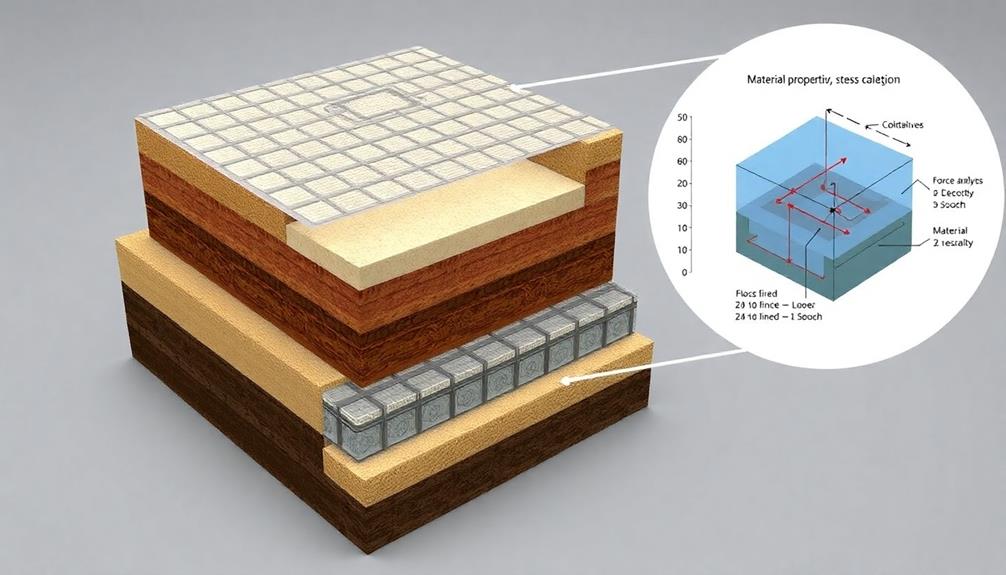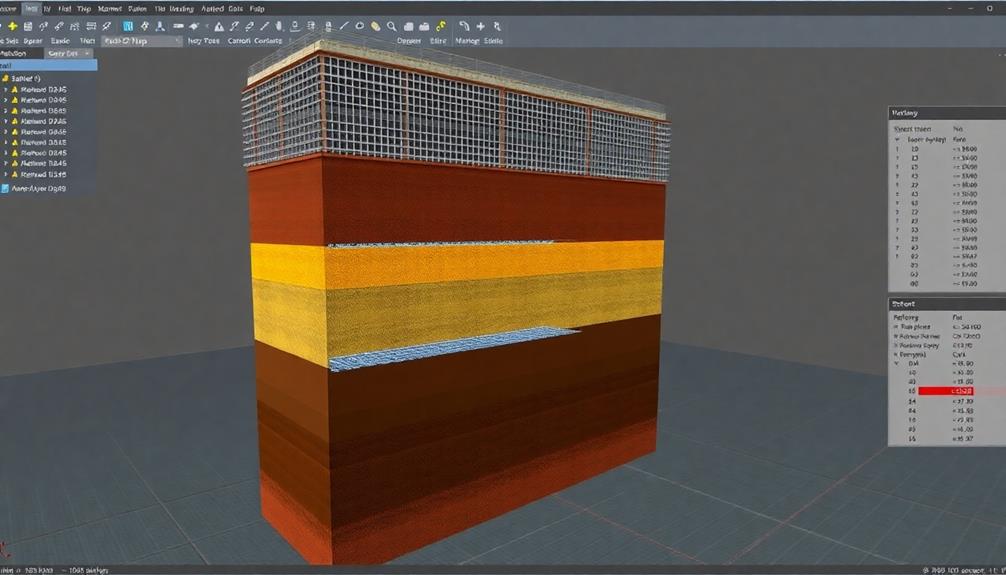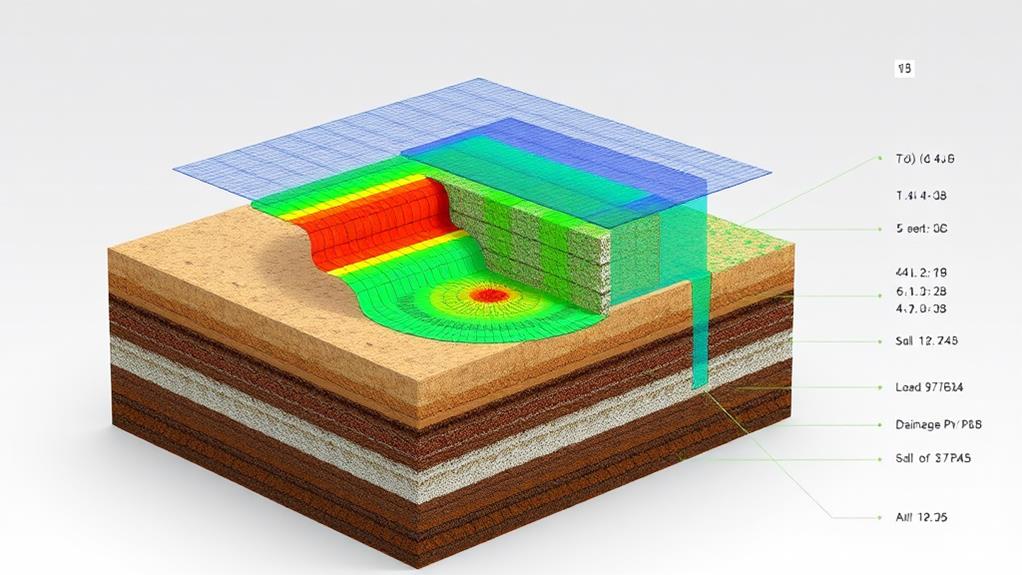Retaining wall engineering software incorporates seven essential features to optimize design and safeguard structural stability. These include core design calculation modules for thorough analysis, stability analysis tools for evaluating sliding and overturning risks, load calculation functions for appraising various forces, and material property specifications for accurate modeling. The software also offers improved design accuracy through advanced algorithms, significant time and cost savings by streamlining workflows, and enhanced project collaboration capabilities. These features collectively enable engineers to produce safe, cost-effective, and durable retaining wall solutions while adhering to industry standards and regulations. Further exploration of these elements reveals their critical role in modern geotechnical engineering practices.
Table of Contents
ToggleWalls Contractor Highlights
- Core design calculation modules for stability analysis, load calculations, and material property specifications.
- Stability analysis tools to evaluate sliding, overturning, and bearing capacity of retaining walls.
- Load calculation functions for analyzing static and dynamic loads, including soil pressure and seismic forces.
- Material property specifications with extensive databases and customization options for project-specific requirements.
- Enhanced project collaboration features to facilitate communication, data sharing, and compliance management among team members.
Core Design Calculation Modules

The core design calculation modules in retaining wall engineering software form the backbone of the system's analytical capabilities. These modules typically encompass stability analysis tools for evaluating factors of safety against overturning, sliding, and bearing capacity failures; load calculation functions for determining earth pressures, surcharges, and seismic forces; and material property specifications for accurately modeling soil and structural elements.
Advanced software also includes features for boulder retaining walls, which are known for their durability and aesthetic appeal. These modules can help engineers design walls that not only prevent erosion but also serve as decorative extensions of homes.
Stability Analysis Tools
Core calculation modules form the backbone of retaining wall engineering software, with stability analysis tools playing a crucial role in ensuring structural integrity. These sophisticated tools utilize complex algorithms to evaluate various stability factors, including sliding, overturning, and bearing capacity. By incorporating geotechnical parameters, such as soil properties and groundwater conditions, these modules provide engineers with an extensive assessment of the retaining wall's performance under different loading scenarios.
The stability analysis tools typically include features for both internal and external stability calculations. Internal stability assessments focus on the structural components of the wall, analyzing reinforcement requirements and potential failure planes within the structure. External stability evaluations consider the wall's interaction with surrounding soil and external forces, such as seismic loads and surcharge pressures.
Advanced software packages may also incorporate probabilistic analysis methods, allowing engineers to quantify the likelihood of failure and optimize design parameters accordingly. By integrating these robust stability analysis tools, retaining wall engineering software empowers professionals to create safer, more efficient designs that meet stringent safety standards and project requirements.
Load Calculation Functions
Integral to retaining wall engineering software, load calculation functions serve as essential components within core design calculation modules. These sophisticated algorithms analyze various forces acting upon the retaining wall structure, ensuring precise and reliable design outcomes. By incorporating complex mathematical models, these functions account for both static and dynamic loads, including soil pressure, surcharge loads, and seismic forces.
The load calculation functions typically encompass:
- Lateral earth pressure computations
- Hydrostatic pressure analysis
- Surcharge load integration
- Seismic load evaluations
Engineers and designers rely on these robust calculation tools to accurately determine the magnitude and distribution of forces acting on retaining walls. This thorough approach enables the software to generate ideal designs that meet safety standards and performance requirements.
The integration of advanced load calculation functions streamlines the design process, reducing the potential for errors and enhancing overall efficiency. By leveraging these powerful computational capabilities, retaining wall engineering software empowers professionals to tackle complex projects with confidence, ensuring the longevity and stability of critical infrastructure. As technology continues to evolve, these functions will certainly become even more refined, further solidifying their role as indispensable tools in the field of geotechnical engineering.
Material Property Specifications
Complementing the load calculation functions, material property specifications form another essential component of core design calculation modules in retaining wall engineering software. These specifications enable engineers to define and analyze the physical characteristics of various materials used in retaining wall construction, ensuring structural integrity and longevity.
The software typically incorporates extensive databases of material properties, including soil types, concrete grades, reinforcement steel, and geosynthetics. Engineers can input specific parameters such as unit weight, friction angle, cohesion, and elasticity modulus for soils; compressive strength, tensile strength, and modulus of elasticity for concrete; and yield strength and ultimate strength for reinforcement steel. Additionally, the software allows for the customization of material properties to accommodate unique project requirements or regional variations in available materials.
Advanced retaining wall engineering software also integrates features for time-dependent material behavior analysis, considering factors such as creep, shrinkage, and degradation over the structure's lifespan. This functionality enables engineers to model long-term performance and durability, facilitating more accurate predictions of structural behavior and maintenance needs. By providing a robust platform for material property specification and analysis, the software empowers engineers to make informed decisions and optimize retaining wall designs for safety, efficiency, and cost-effectiveness.
Benefits

Retaining wall engineering software offers numerous benefits that vastly improve the design and construction process. These advanced tools provide enhanced design accuracy through sophisticated calculation algorithms, while simultaneously delivering time and cost savings by streamlining workflow and reducing manual errors.
Specialized equipment and professional expertise, like those utilized by established retaining wall companies, can be incorporated into the software to guarantee excellent results. Additionally, such software facilitates enhanced project collaboration among team members and simplifies compliance management by incorporating up-to-date industry standards and regulations into the design process.
Improved Design Accuracy
Thanks to advanced algorithms and precise calculations, retaining wall engineering software considerably boosts design precision. These sophisticated programs integrate complex geotechnical principles, structural mechanics, and material science to produce highly reliable and efficient retaining wall designs.
By leveraging vast databases of soil properties, load conditions, and construction materials, the software minimizes human error and complies with industry standards and local regulations.
The improved design precision offered by retaining wall engineering software manifests in several key areas:
- Accurate load calculations, accounting for soil pressures, surcharges, and seismic forces
- Optimized material selection based on site-specific conditions and project requirements
- Precise stability analysis, including global, internal, and external stability checks
- Detailed reinforcement design, guaranteeing proper spacing and embedment of structural elements
Engineers and designers who utilize this software gain a significant advantage in producing cost-effective, safe, and durable retaining wall solutions. The enhanced precision not only reduces the risk of structural failures but also optimizes material usage, potentially leading to substantial cost savings over the project lifecycle.
Additionally, the software's ability to quickly iterate through multiple design scenarios allows for more thorough exploration of alternatives, resulting in better-informed decision-making and improved overall project outcomes.
Time and Cost Savings
A significant advantage of retaining wall engineering software lies in its substantial time and cost savings for construction projects. By automating complex calculations and design processes, these sophisticated tools dramatically reduce the hours engineers spend on manual computations and iterative design revisions. This efficiency translates directly into reduced labor costs and accelerated project timelines, allowing firms to take on more projects and improve their bottom line.
The software's ability to quickly generate multiple design alternatives enables engineers to explore various options and optimize solutions rapidly. This iterative process, which might take days or weeks when performed manually, can be completed in a matter of hours. Additionally, the integration of material databases and cost estimation features within the software allows for real-time budget analysis, helping teams make informed decisions that balance structural integrity with financial constraints.
Enhanced Project Collaboration
Modern retaining wall engineering software substantially enhances project collaboration by providing a centralized platform for all stakeholders. This digital ecosystem allows engineers, architects, contractors, and clients to seamlessly share information, updates, and revisions in real-time. The software's collaborative features facilitate efficient communication, reducing misunderstandings and errors that can arise from outdated or conflicting information.
Key benefits of enhanced project collaboration include:
- Simultaneous access to project files, enabling multiple team members to work concurrently on different aspects of the design
- Version control and change tracking, ensuring all parties are working with the most up-to-date information and can review the project's evolution
- Integrated commenting and markup tools, allowing stakeholders to provide feedback directly within the software interface
- Cloud-based storage and synchronization, enabling access to project data from any location with internet connectivity
Simplified Compliance Management
Retaining wall engineering software streamlines compliance management, offering substantial benefits to project teams. By integrating regulatory requirements and industry standards into the design process, these sophisticated tools guarantee that retaining wall structures adhere to local, state, and federal regulations. This seamless integration allows engineers and designers to focus on innovative solutions while maintaining strict compliance with evolving codes and guidelines.
The software's extensive database of compliance parameters automatically updates with the latest regulatory changes, eliminating the need for manual tracking and reducing the risk of oversights. It provides real-time compliance checks during the design phase, flagging potential issues and suggesting corrective measures. This proactive approach drastically reduces the likelihood of costly redesigns or construction delays due to non-compliance.
Furthermore, the software generates detailed compliance reports, documenting how each aspect of the retaining wall design meets or exceeds regulatory requirements. These reports serve as valuable documentation for project approvals, inspections, and future audits. By simplifying compliance management, retaining wall engineering software not only enhances project efficiency but also fosters a culture of regulatory adherence within the engineering community, ensuring safer and more sustainable infrastructure development.
Soil-Structure Interaction Analysis Capabilities

Retaining wall engineering software offers sophisticated soil-structure interaction analysis capabilities that enhance design accuracy and reliability. These tools incorporate advanced soil property modeling, allowing engineers to account for complex soil behaviors and their effects on wall performance. Through precise load distribution calculations and settlement prediction tools, the software enables engineers to maximize designs for various soil conditions and loading scenarios, ensuring long-term stability and structural integrity.
| Analysis Feature | Functionality | Design Impact |
|---|---|---|
| Soil Property Modeling | Simulates soil behavior under various conditions | Improves accuracy of wall design for specific soil types |
| Load Distribution Calculations | Computes forces acting on wall components | Enables ideal sizing and reinforcement of structural elements |
| Settlement Prediction | Estimates long-term soil deformation | Aids in preventing future structural issues and maintenance needs |
Advanced Soil Property Modeling
Advanced soil property modeling capabilities in retaining wall engineering software enable sophisticated soil-structure interaction analysis. These features allow engineers to accurately represent complex soil behaviors, including non-linear stress-strain relationships, time-dependent deformation, and pore water pressure effects. By incorporating advanced soil models, designers can better predict the long-term performance of retaining walls under various loading conditions and environmental factors.
Key aspects of advanced soil property modeling in retaining wall software include:
- Implementation of constitutive models such as Mohr-Coulomb, Drucker-Prager, and Cam-Clay
- Ability to account for soil anisotropy and stress-dependent stiffness
- Integration of seepage analysis and coupled hydro-mechanical behavior
- Incorporation of soil-specific parameters like void ratio, consolidation coefficients, and shear strength
These advanced modeling capabilities empower engineers to make more informed decisions regarding retaining wall design, ultimately leading to safer and more cost-effective structures. By utilizing software with sophisticated soil property modeling, professionals in the field can stay at the forefront of geotechnical engineering practices, ensuring their designs meet the highest standards of safety and efficiency. This level of detail in soil modeling is particularly essential for complex projects involving challenging soil conditions or high-risk environments.
Load Distribution Calculations
At the heart of effective retaining wall design lies the ability to accurately calculate load distribution through soil-structure interaction analysis. Advanced retaining wall engineering software incorporates sophisticated algorithms that model the complex interplay between soil and structural elements.
These calculations consider factors such as soil pressure, surcharge loads, hydrostatic forces, and seismic influences to determine the precise distribution of stresses along the wall's height and foundation.
The software's load distribution modules typically employ finite element analysis or limit equilibrium methods to simulate real-world conditions. Engineers can input site-specific parameters, including soil stratification, groundwater levels, and material properties, to generate detailed load diagrams and moment distribution curves.
This level of precision allows for the optimization of wall thickness, reinforcement placement, and foundation design, ensuring both safety and cost-effectiveness.
Furthermore, advanced software packages offer the capability to perform sensitivity analyses, enabling designers to assess the impact of varying load conditions and soil properties on wall stability. This feature is particularly valuable for projects in geologically complex areas or those subject to dynamic loading scenarios, providing engineers with the tools to create robust designs that meet stringent safety standards while maximizing structural efficiency.
Settlement Prediction Tools
Invariably, the accurate prediction of settlement is essential for the long-term stability and performance of retaining walls. Advanced retaining wall engineering software incorporates sophisticated settlement prediction tools that enable engineers to model complex soil-structure interactions. These tools utilize finite element analysis and empirical methods to forecast potential settlement issues, allowing for proactive design modifications and mitigation strategies.
The settlement prediction capabilities of modern software typically include:
- Time-dependent consolidation analysis
- Elastic and plastic deformation modeling
- Soil creep and secondary compression calculations
- Differential settlement assessment across the wall's length
Walls Contractor FAQ
How Much Training Is Required to Use Retaining Wall Engineering Software Effectively?
The training required for effective use of retaining wall engineering software varies depending on the user's background. Typically, engineers can become proficient within a few weeks of dedicated practice, while those new to the field may need several months.
Can the Software Integrate With Building Information Modeling (Bim) Systems?
Many retaining wall engineering software solutions offer BIM integration capabilities. This allows seamless collaboration between structural engineers and other project stakeholders, enhancing workflow efficiency and data consistency throughout the design and construction process. Compatibility varies between software providers.
What File Formats Are Supported for Importing and Exporting Data?
Common file formats supported for data import/export typically include DXF, DWG, PDF, and Excel spreadsheets. Industry-standard formats like IFC for BIM integration are also often available. These options guarantee seamless collaboration and data sharing among team members.
Is the Software Suitable for Both Small-Scale and Large-Scale Retaining Wall Projects?
Our software caters to projects of all sizes, from small residential walls to large-scale commercial developments. We grasp your need for versatility, and our team has designed the program to adapt seamlessly to any project scope you encounter.
Does the Software Offer Cloud-Based Collaboration Features for Team Projects?
Many modern retaining wall engineering software solutions offer cloud-based collaboration features, allowing team members to work together seamlessly on projects. These features typically include real-time updates, shared access to designs, and communication tools for efficient teamwork.







